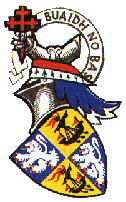
|
MacDougalls on the Net Clan MacDougall Discussion Area Clan MacDougall Contacts |

|
MacDougalls on the Net Clan MacDougall Discussion Area Clan MacDougall Contacts |

Ewan held his island possessions from the King of Norway and his mainland ones from the king of Scots, and he found it hard to remain loyal to both. A choice was forced upon him in 1263, when King Haakon of Norway arrived off Oban with a huge fleet for his planned invasion of the west coast of Scotland. Ewan declined to join the invasion and because of the old blood ties, Haakon left him in peace. However, Ewan saw that neutrality would ultimately lead to disaster, and attacked part of the Norse fleet near Mull. The Vikings were utterly defeated at the battle of Largs, and three years later all of the Hebrides were ceded by Norway to Scotland.
 Their influence in Argyll brought them into conflict with the Campbells, and in 1294 John Macdougall, the Lame, led the clan against them. At the path of Lorn, between Loch Avich and Scammadale, the MacDougalls were intercepted, and although Sir Colin Campbell was killed, there was considerable slaughter on both sides.
The marriage of the fourth chief, Sir Alexander MacDougall, was disastrous for his clan. His wife was the sister of John Comyn, Lord of Badenoch, whose son, generally called the Red Comyn, was stabbed to death by Robert the Bruce in the greyfriars Church in Dumfries in May 1306. This started a blood feud with Bruce's family and the MacDougalls, who had supported Wallace and the cause of Scottish independence, now became implacable enemies. Shortly after his hurried coronation at Scone, King Robert was forced to retreat before the victorious English into Argyll, hoping to reach his Campbell allies. The MacDougalls surprised the king at Dalrigh near Tyndrum. The king escaped, but it is said that on his discarded cloak was found a magnificent example of Celtic jewellery which was later known as the 'brooch of Lorne', and it became one of the clan's great treasures. Two years later Bruce led three thousand battle-hardened veterans into Argyll against them. John of Lorne set an ambush for the king's army at the narrow pass of Brander, but after a savage engagement they were broken and forced to flee. The King formally forfeited the MacDougall lands, most of which passed to the Campbells in recognition of their loyalty.
Their influence in Argyll brought them into conflict with the Campbells, and in 1294 John Macdougall, the Lame, led the clan against them. At the path of Lorn, between Loch Avich and Scammadale, the MacDougalls were intercepted, and although Sir Colin Campbell was killed, there was considerable slaughter on both sides.
The marriage of the fourth chief, Sir Alexander MacDougall, was disastrous for his clan. His wife was the sister of John Comyn, Lord of Badenoch, whose son, generally called the Red Comyn, was stabbed to death by Robert the Bruce in the greyfriars Church in Dumfries in May 1306. This started a blood feud with Bruce's family and the MacDougalls, who had supported Wallace and the cause of Scottish independence, now became implacable enemies. Shortly after his hurried coronation at Scone, King Robert was forced to retreat before the victorious English into Argyll, hoping to reach his Campbell allies. The MacDougalls surprised the king at Dalrigh near Tyndrum. The king escaped, but it is said that on his discarded cloak was found a magnificent example of Celtic jewellery which was later known as the 'brooch of Lorne', and it became one of the clan's great treasures. Two years later Bruce led three thousand battle-hardened veterans into Argyll against them. John of Lorne set an ambush for the king's army at the narrow pass of Brander, but after a savage engagement they were broken and forced to flee. The King formally forfeited the MacDougall lands, most of which passed to the Campbells in recognition of their loyalty.
The MacDougalls were never to regain their island possessions, but to a large degree their fortunes were restored when Euan MacDougall married a granddaughter of Robert the Bruce. Most of the mainland estates were re-granted by a royal charter of David II. When the last MacDougall Lord of Lorne died, leaving an only daughter who had married Sir John Stewart , the lordship passed to the family. The chiefship then devolved to a line which had supported Bruce and had been granted Dunollie Castle, which the chief had forfeited in 1314.
During the troubled times of the early seventeenth century the MacDougalls were generally royalist, and in 1645, Alexander MacDougall led five hundred of his clansmen into battle. After the defeat of the Marquess of Montrose, a Covenanting army under David Leslie was sent to Argyll to deal with royalist sympathisers.
On the restoration of the monarchy the MacDougall lands were again restored. Their loyalty to the Stewarts was proved again when the twenty-second chief, Iain Ciar, fought in the rising of 1715 at the Battle of Sheriffmuir. The chief was forced into exile, but later returned to Scotland to live as a fugitive until he was pardoned in 1727. His son, Alexander, although certainly a Jacobite sympathiser, did not join the Forty-five, although his brother and some clansmen fought at Culloden. Alexander built a more modern house behind Dunollie Castle and it was extended in the mid-nineteenth century by the twenty-fifth chief, Vice Admiral Sir John MacDougall of MacDougall. He had a distinguished naval career and actively promoted the development of the port of Oban. Three of his sons were to become chiefs in succession.






